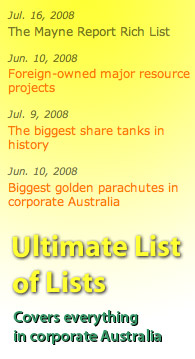Shareholders Association gets an AGM grilling
By Stephen Mayne
January 14, 2008
The ASA AGM was on May 1, 2006 and this was in Crikey the following day.
On 364 days a year, the Australian Shareholders' Association is dedicated to holding Australia's top 150 companies to account and, if necessary, grilling boards at annual general meetings. However, the tables were turned yesterday when the ASA board fronted its own AGM in Melbourne and we had a solid 90-minute debate about its performance, policies and financials.
Stagnant membership numbers of just over 7,000 for the past five years is now the subject of special board meetings – how can the ASA boost its numbers, generate extra revenue and become a more effective advocate for shareholders? After several members offered up suggestions, I got up and gave an explanation of the Crikey model, which would substantially boost the ASA.
Firstly, get rid of a password protected member only website. As one member correctly pointed out, how can the ASA maximise proxy solicitation if non-members are locked out? Throw it open to everyone as a window for prospective members to sample what is on offer if they pay up just $95 a year.
Secondly, cut the costly printed magazine Equity down from six to four editions a year and introduce regular email updates whenever you've got something to say. Despite its elderly 55-plus demographic, 60% of ASA members are on email and this is growing every year.
Next, stop having private pre-AGM exchanges with companies because it telegraphs the punches and reduces the ASA's presence at the actual public meetings, which in turn means they generate fewer media mentions – a vital ingredient for growing the membership base.
I've lost count of the number of times an ASA representative opens up by saying: "good morning chairman, congratulations on the wonderful performance, thank you for answering my 12 written questions and inviting us in for a cup of tea last week, now can you please just clarify this one point."
Towards the end of yesterday's exchanges with the rather defensive ASA chairman Stephen Matthews, I pointed out that the very debate we were having – unscripted, no forewarning and bouncing off what other members were saying – was exactly how the ASA should approach the top 150 companies. The argument that chairs might not be able to produce an answer is wrong, because the full board and management team is usually present to assist.
Finally, just because profits and dividends are up, doesn't mean there aren't still interesting questions to be asked and – heaven forbid – occasionally they should even stray into non-financial areas, such as problem gambling at an outfit like pokies giant Aristocrat Leisure.
My approach is to underwrite the debate at an AGM. You start out perfectly happy to say nothing, but if no-one else is contributing then you keep hammering away up to a maximum of two hours, provided the audience is with you. The ASA should do the same because there is no point attending an AGM of a booming company and saying nothing.
When it came to the re-election of Matthews a deal was proposed – if the ASA ended its record of recommending against all 22 of my public company board tilts over the past six years when a tilt at Macquarie Bank materialises in July, Matthews would have my vote. It was a joke, of course, with a bit of a kicker about the ASA's reluctance to endorse outsiders.
The only other points I raised were a request for the age and backgrounds of directors to be published in the annual report and a criticism of the ASA for supporting the 100 signature requirement for shareholder resolutions. The government came up with a proposal to reduce this to 20 signatures – something Matthews wrongly suggested I was responsible for – but then backed off when companies complained and the ASA inexplicably advocated no change.
If owning $US2000 worth of stock is good enough for a shareholder resolution in the US, surely 20 signatures would suffice here and help us develop a greater culture of shareholder pressure. All this paranoia about special interest groups taking over is rubbish when you consider that 100 signatures have only been successfully gathered 24 times over the past 15 years across the entire 1,600-plus companies listed on the ASX.
The ASA does a solid job, but it could do better. A tilt at the board in 2007 is not entirely out of the question if performance doesn't improve, although there would be some conflicts of interest to work through, plus potential constraints on AGM activity whilst inside their tent.
Copyright © 2024 The Mayne Report. All rights reserved






















